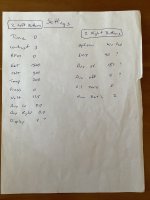Van's Air Force
You are using an out of date browser. It may not display this or other websites correctly.
You should upgrade or use an alternative browser.
You should upgrade or use an alternative browser.
Help with setting EIS warning limits.
- Thread starter KazooRV-9A
- Start date
Desert Rat
Well Known Member
There's a natural tendency is to be conservative with your limits, but if you do that, it seems to me that you're just asking for distractions during your first flight. You don't want to have a bunch of cautions going off if you're still in the normal operating parameter and there's not really anything wrong.
I just went with the real published limits from Lycoming etc. Whatever the vendor says is the real world in service limit. I also stuck a yellow band a reasonable distance before that so I can take action if something is creeping up on the hard stop.
I just went with the real published limits from Lycoming etc. Whatever the vendor says is the real world in service limit. I also stuck a yellow band a reasonable distance before that so I can take action if something is creeping up on the hard stop.
I set the limits in the efis a little lower than in the EIS, e.g., efis flashes red if cht exceeds 420 F. (Meaning, watch this). EIS idiot light flashes red if CHT exceeds 430 (meaning, fix this now!) Obviously I consider Lycoming’s 500 limit idiotic. I set buss voltage limit at 13.8 (normal is 14.3). This gives instant notification of alternator failure.
FireMedic_2009
Well Known Member
I would increase the voltage to at least 12.5 or more so you know immediately when you lose your alternator. While it’s operating the alternator is outputting over 13V.
Desert Rat
Well Known Member
Like I said in my first post this kind of thing should fall under the category of “whatever the vendor says is the real world limit”.I would increase the voltage to at least 12.5 or more so you know immediately when you lose your alternator. While it’s operating the alternator is outputting over 13V.
Your 12.5 number is too low for a system that uses an earthX battery. Their resting voltage is 13.5-13.8. I have an earthX and a B&C voltage regulator set at 14.2 volts so I have my voltmeter set at 14.0.
But I had to get into the book for my particular components to validate and decide what those numbers should be.
I think for mine we just used the vans dial gauges as a reference for limits, has worked well except at idle the low oil pressure tends to pop on around 50psiI have a GRT sport display and EIS in my RV-9A build. Can builders suggest warning limits for the EIS?
View attachment 64767View attachment 64767
dmattmul
Well Known Member
Agreed, resting voltage is very important and setting to the upper end good advice. Probably best to check what your resting voltage actually is and set the limits for a few tenths above that. Resting voltage may be different to each airframe and dependent on voltage drop to the bus that it is sensing. My main bus resting voltage is ~ 13.7 volts but my essential bus is ~ 13.4 volts. Same type Earth X battery at each bus. Monitoring voltage will give you an early indication of an alternator failure but if using an Earth X battery, the voltage at different charging levels (25 to 75%) very similar so setting resting voltage accurately needed. My favorite go to instrument is B lead shunts. You will know within seconds if you have an alternator failure.Like I said in my first post this kind of thing should fall under the category of “whatever the vendor says is the real world limit”.
Your 12.5 number is too low for a system that uses an earthX battery. Their resting voltage is 13.5-13.8. I have an earthX and a B&C voltage regulator set at 14.2 volts so I have my voltmeter set at 14.0.
But I had to get into the book for my particular components to validate and decide what those numbers should be.
Last edited:






